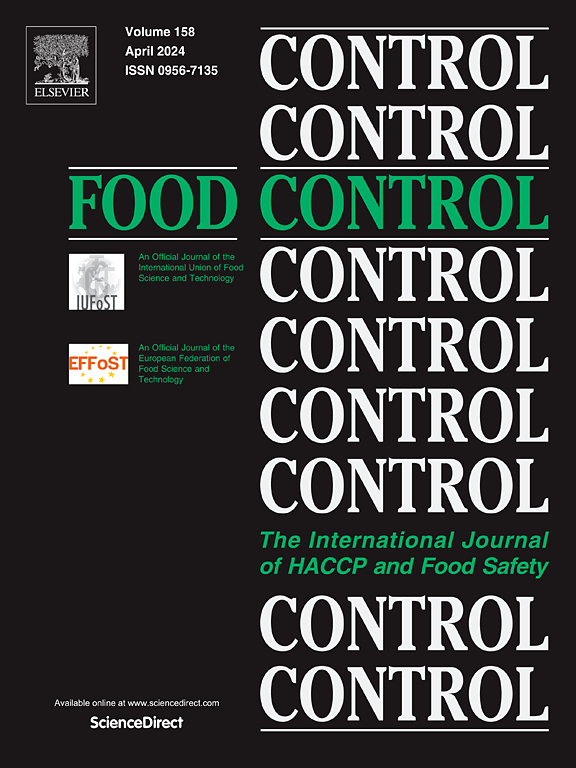关于一些低成本鱼类品种的感官、理化、细菌学、营养质量、重金属含量和健康风险评估的比较研究
IF 5.6
1区 农林科学
Q1 FOOD SCIENCE & TECHNOLOGY
引用次数: 0
摘要
调查鱼类质量、营养成分和重金属健康风险评估可为食用海产品和保护人类健康提供重要指导。因此,目前的研究旨在评估一些广泛食用的鱼类的质量和安全性,并认识到在埃及广泛存在的更多种类的鱼类,其成本合理、营养价值高、质量好且可供人类安全食用。为实现这一目标,研究人员从吉萨当地的鱼类市场采集了 100 份鲜鱼样本,包括红猪、沙丁鱼、鳗鱼、草鱼和鲤鱼(各 20 份),并对其化学成分、细菌学质量、变质标准、感官属性、重金属含量和健康风险评估进行了检测。与鲤鱼相比,红鲷鱼的蛋白质和感官评分明显较高,而脂肪、细菌数量、pH 值、总挥发性碱基氮和三甲胺值则明显较低。不过,沙丁鱼和鳗鱼的硫代巴比妥酸、游离脂肪酸和酸值均高于红猪。令人惊讶的是,草鱼中的铅含量、所有检测样本中的汞含量以及鲤鱼中的砷含量均低于检测限值。尽管所有鱼类样本的重金属目标危害商数和危害指数均低于 1,但由于食用鱼类所摄入的重金属并不包括每天从所有膳食来源摄入的重金属总量,因此无法确认食用这些鱼类会对健康造成可接受的非致癌风险。此外,鱼类样本中所有受检重金属的致癌风险均高于 10-6,表明致癌风险很高,需要下大力气将其降低到安全范围内。总之,本次研究为埃及社会提供了有益的数据,有助于人们选择营养价值高、质量好、价格合理的海产品。本文章由计算机程序翻译,如有差异,请以英文原文为准。
A comparative study concerning the sensory, physicochemical, bacteriological, nutritional quality, heavy metal content, and health risk assessment of some low-cost fish species
Investigating fish quality, nutritional content, and health risk assessment for heavy metals can provide important guidance on eating seafood and protecting human health. Accordingly, the current research aimed to assess the quality and safety of some extensively consumed fish and recognize more types of fish widely available in Egypt with reasonable costs, high nutritional values, good quality, and safe for human consumption. To achieve this goal, 100 fresh fish samples including red porgy, sardine, eel fish, grass carp, and common carp (20 from each) were taken from local fish markets in Giza and examined for chemical composition, bacteriological quality, deterioration criteria, sensory attributes, heavy metal contents, and health risk assessment. Among the examined fish, red porgy exhibited significantly higher protein and sensory scores along with significantly lower fat, bacterial count, pH, total volatile base nitrogen, and trimethylamine values in contrast to carp fish. Nevertheless, sardine and eel fish obtained the highest values of thiobarbituric acid, free fatty acid, and acid number versus red porgy. Surprisingly, the concentrations of lead in grass carp fish, mercury in all examined samples, as well as arsenic in common carp fish, were lower than the detectable limits. Despite the target hazard quotient and hazard index of all examined heavy metals being below 1 in all fish samples, it could not be confirmed that eating such fish causes acceptable non-carcinogenic health risks due to exposure from fish consumption does not account for the total daily exposure to the heavy metal from all dietary sources. Moreover, the carcinogenic risk of all examined heavy metals in fish samples was higher than 10−6 indicating a high risk of carcinogenicity which needs great efforts to be reduced to the safe limits. In conclusion, the current study provides beneficial data to Egyptian society for choosing seafood with high nutritional value, good quality, and affordable prices.
求助全文
通过发布文献求助,成功后即可免费获取论文全文。
去求助
来源期刊

Food Control
工程技术-食品科技
CiteScore
12.20
自引率
6.70%
发文量
758
审稿时长
33 days
期刊介绍:
Food Control is an international journal that provides essential information for those involved in food safety and process control.
Food Control covers the below areas that relate to food process control or to food safety of human foods:
• Microbial food safety and antimicrobial systems
• Mycotoxins
• Hazard analysis, HACCP and food safety objectives
• Risk assessment, including microbial and chemical hazards
• Quality assurance
• Good manufacturing practices
• Food process systems design and control
• Food Packaging technology and materials in contact with foods
• Rapid methods of analysis and detection, including sensor technology
• Codes of practice, legislation and international harmonization
• Consumer issues
• Education, training and research needs.
The scope of Food Control is comprehensive and includes original research papers, authoritative reviews, short communications, comment articles that report on new developments in food control, and position papers.
 求助内容:
求助内容: 应助结果提醒方式:
应助结果提醒方式:


